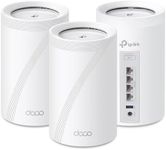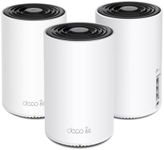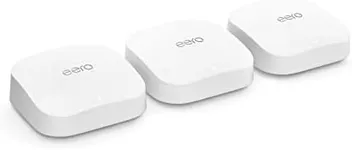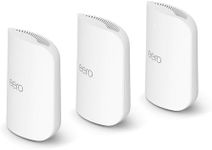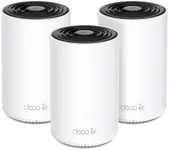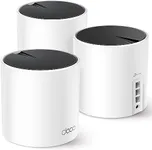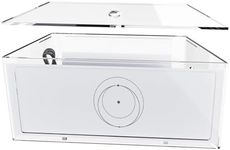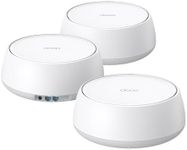Buying Guide for the Best Mesh Wifi Systems With High Speed Performance
Choosing the right mesh Wi-Fi system can significantly improve your internet experience by providing seamless coverage throughout your home or office. Mesh Wi-Fi systems consist of multiple devices that work together to create a single, unified network, eliminating dead zones and ensuring a strong, consistent signal everywhere. To find the best fit for your needs, it's important to understand the key specifications and how they impact performance and usability.Coverage AreaCoverage area refers to the total space that the mesh Wi-Fi system can effectively cover with a strong signal. This is important because it determines how well the system will work in your specific environment. Coverage areas are typically measured in square feet. For small apartments or homes (up to 1,500 sq. ft.), a single unit or a basic mesh system may suffice. For medium-sized homes (1,500-3,000 sq. ft.), a system with two or three units is usually ideal. For large homes or properties (over 3,000 sq. ft.), you may need a more extensive system with additional units. Consider the size of your space and any potential obstacles like walls or floors that could affect signal strength.
SpeedSpeed refers to the maximum data transfer rate that the mesh Wi-Fi system can handle, usually measured in megabits per second (Mbps) or gigabits per second (Gbps). This is crucial for activities like streaming, gaming, and video conferencing, which require high-speed internet. Entry-level systems may offer speeds up to 300 Mbps, which is suitable for basic browsing and streaming. Mid-range systems typically provide speeds between 300 Mbps and 1 Gbps, ideal for multiple devices and moderate usage. High-end systems can offer speeds exceeding 1 Gbps, perfect for heavy usage, smart homes, and multiple high-bandwidth activities. Assess your internet usage and the number of devices connected to determine the appropriate speed for your needs.
Number of UnitsThe number of units in a mesh Wi-Fi system determines how many devices you can place around your home to extend coverage. This is important for ensuring that every corner of your space receives a strong signal. Basic systems may come with one or two units, suitable for smaller spaces. More comprehensive systems include three or more units, which are better for larger homes or properties with multiple floors. Consider the layout of your home and the areas where you need the strongest signal to decide how many units you require.
Band SupportBand support refers to the frequency bands that the mesh Wi-Fi system can operate on, typically 2.4 GHz and 5 GHz. This is important because different bands offer different benefits. The 2.4 GHz band provides a longer range but slower speeds, making it suitable for basic tasks like browsing and email. The 5 GHz band offers faster speeds but a shorter range, ideal for high-bandwidth activities like streaming and gaming. Some advanced systems also support a third band (tri-band), which can further improve performance by dedicating one band to communication between units. Consider your internet activities and the layout of your home to choose a system with the appropriate band support.
Ease of Setup and ManagementEase of setup and management refers to how simple it is to install and maintain the mesh Wi-Fi system. This is important because a user-friendly system can save you time and frustration. Many modern systems offer app-based setup and management, allowing you to control your network from your smartphone. Look for features like guided installation, automatic updates, and easy device management. If you're not tech-savvy, prioritize systems with straightforward setup processes and intuitive management interfaces.
Security FeaturesSecurity features refer to the protections that the mesh Wi-Fi system offers to keep your network and data safe. This is crucial for preventing unauthorized access and protecting your personal information. Common security features include WPA3 encryption, automatic firmware updates, and built-in firewalls. Some systems also offer parental controls and guest network options. Consider the level of security you need based on your internet usage and the sensitivity of the data you handle. Opt for systems with robust security features to ensure your network remains secure.
